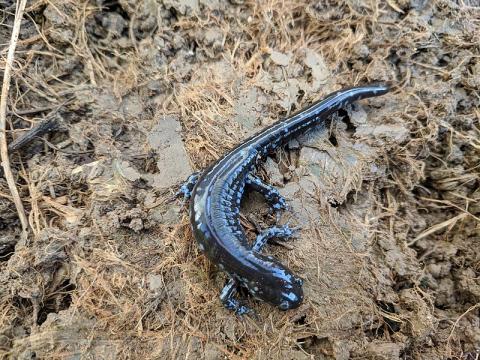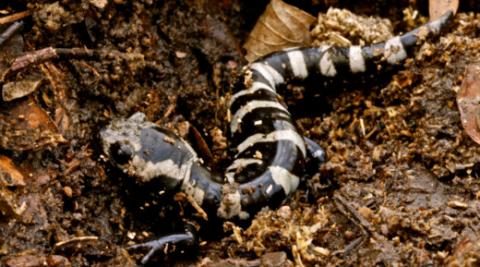What Attributes of Road Crossings are Most Effective in Aiding Successful Amphibian Species Migration?
Amphibian species play essential roles in local ecosystems by contributing to food webs as both predators and prey, undertaking an important role in carbon sequestration and serving as indicators of a healthy ecosystem. Some of these amphibian species use seasonal bodies of water called vernal pools for their breeding habitat. These are known as vernal pool primary indicator amphibian species and they include wood frog (Lithobates sylvaticus), spotted salamander (Ambystoma maculatum), blue-spotted salamander (Ambystoma laterale), Jefferson salamander (Ambystoma jeffersonianum) and marbled salamander (Ambystoma opacum).
Vernal pool primary indicator amphibian species will migrate up to 1 km on the “Big Night” – the first rainy, warm night of spring when temperatures remain above 42 degrees Fahrenheit. Among the many obstacles that amphibian species face during migration are roadways, often leading to mortality. A common practical solution that has been implemented since the 1960s to help aid in amphibian species migration across roadways is the construction of wildlife underpasses, specifically tunnels or culverts.
For a graduate research project at Unity College, I conducted a meta-analysis to analyze what attributes of road crossings are the most effective in aiding in successful amphibian species migration. Research has shown that some of the most significant attributes of crossing designs include specified crossing dimensions, crossing material, native substrate within the crossing and drift fencing.
- Crossing dimensions: the dimensions within a crossing that can be thought of as the openness of the inlet and outlet, paired with the length of the structure. For rectangular crossings, this would be the length, width, and height of the structure. For circular crossings, this would be the diameter of the inlet and outlet and the length of the crossing.
- Crossing material: crossing material is simply the material that makes up a structure, or what a structure is composed of. Some example materials include concrete, plastic or metal.
- Native substrate: native substrate is the material that covers the bottom of the crossing at a certain depth. Native substrate is typically a natural material that mimics the surrounding soil characteristics, and that holds in moisture.
- Drift fencing: drift fencing is a long, continuous fence that extends outward of the inlet and outlet of the crossing and is used to direct and redirect amphibian species towards the inlet and outlet for safe migration.
Through my meta-analysis, it was discovered that drift fencing reduced road mortality rates by over 50% if the fencing extended greater than or equal to 50 meters from the inlets and outlets of the crossing. It was also discovered that crossings that were embedded with a sandy substrate or a loamy sand were significantly more effective in aiding in amphibian species migration compared to a bare culvert or a culvert embedded with concrete. Also, amphibian species preferred and more frequently migrated through crossings with rectangular dimensions over crossings with circular dimensions. If circular culverts were used within experimental design, openings/dimensions of greater than 0.4 meters were determined to be the minimum preferred size by salamander and frog species. 0.4 meters is about equal to 16 inches, which I was surprised to learn as the minimum size of a crossing typically proposed within our state is usually around 18 inches. The main assumption is that crossings in New Hampshire are not only constructed to aid in amphibian species migration, but also to aid in smaller mammal and reptile species migration and to maintain hydrologic connection between surrounding wetlands.
(Top, L to R: blue-spotted salamander, Jefferson salamander; Bottom, L to R: marbled salamander, wood frog)
With the help of UNH Extension Wildlife Outreach Program Manager Haley Andreozzi, these results were translated into proposed crossing designs that could be used as an example to illustrate what attributes can effectively aid in amphibian species migration. Andreozzi, who specializes in providing technical assistance for public outreach, citizen science and stewardship projects related to New Hampshire’s wildlife species and their habitat, served as a professional partner and expert to help successfully translate these results into practical designs and information that were incorporated into a fact sheet. A professional should always be involved in designing crossings due to unique characteristics at each designated site, but this fact sheet can be used as guidance for crossing design development and amphibian species conservation. Please click the link below to put a picture to the amphibian species that were included within this research and to see some examples of what a suitable road crossing design would look like.
These sample designs were created to illustrate which crossing attributes work best in certain situations, allowing for light exposure and ample moisture content to help guide amphibian species through the crossing during migration. My hope is that this project demonstrates suitable road crossings that can be used in development, taking into consideration primary indicator vernal pool amphibian species and their respective migration patterns, while ultimately minimizing road mortality rates where possible.
Sources
Beebee, T. J. C. (2013). Effects of road mortality and mitigation measures on amphibian populations. Conservation Biology, 27 (4), 657-668.
Hedrick, B. P., Linden, A. B., Cordero, S. A., Watt, E., O’Roark, P. M., Cox, S. L., and Sutherland, C. (2019). Keeping salamanders off the streets: evaluating and modifying one of the first US amphibian road tunnels 30 years after installation. Journal of Urban Ecology, 5 (1), 1-7.
Malt, J. (2011). Assessing the effectiveness of amphibian mitigation on the Sea to Sky Highway: Passageway use, roadkill mortality, and population level effects. Herpetofauna and Roads Workshop - Is there light at the end of the tunnel? Vancouver Island University, Nanaimo, Canada, 17-18.
Rosell C., Parpal J., Campeny R., Jove S., Pasquina A. & Velasco J.M. (1997). Mitigation of barrier effect on linear infrastructures on wildlife (pp. 367-372). Habitat Fragmentation & Infrastructure. Ministry of Transport, Public Works and Water Management, Delft, Netherlands.
Extension Contact




